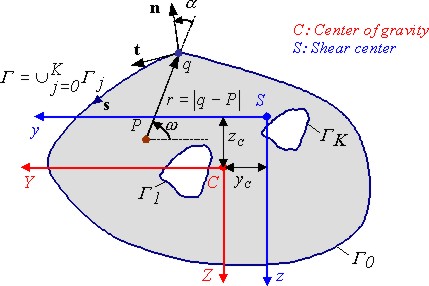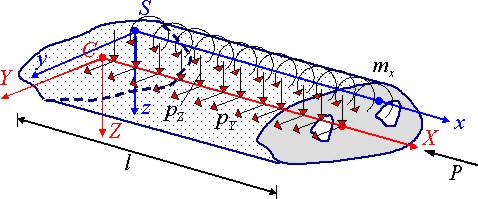
engineering & technology publications
ISSN 1759-3433
PROCEEDINGS OF THE TENTH INTERNATIONAL CONFERENCE ON CIVIL, STRUCTURAL AND ENVIRONMENTAL ENGINEERING COMPUTING
Flexural-Torsional Vibrations of Beams by the BEM
School of Civil Engineering, National Technical University of Athens, Greece
In this investigation a boundary element method is developed for the general flexural-torsional vibrations of Euler-Bernoulli beams of arbitrarily shaped cross section. The beam is subjected to arbitrarily transverse and/or torsional distributed or concentrated loading, while its edges are restrained by the most general linear boundary conditions. The resulting initial boundary value problem, described by three coupled partial differential equations, is solved employing a boundary integral equation approach. Besides the effectiveness and accuracy of the developed method, a significant advantage is that the displacements as well as the stress resultants are computed at any cross-section of the beam using the respective integral representations as mathematical formulae. The general character of the proposed method is verified from the fact that all basic equations are formulated with respect to an arbitrary coordinate system, which is not restricted to the principal one. Both free and forced vibrations are examined. Several beams are analysed to illustrate the method and demonstrate its efficiency and wherever possible its accuracy. The range of applicability of the thin-tube theory is also investigated.
Let us consider an initially straight Euler-Bernoulli beam of length ![]() (Figure 108.1), of
constant arbitrary cross-section of area
(Figure 108.1), of
constant arbitrary cross-section of area ![]() . The homogeneous isotropic and linearly
elastic material of the beam cross-section occupies the region
. The homogeneous isotropic and linearly
elastic material of the beam cross-section occupies the region ![]() of the
of the ![]() plane
and is bounded by the
plane
and is bounded by the
![]() boundary curves, which are piecewise
smooth, i.e. they may have a finite number of corners. In Figure 108.1a,
boundary curves, which are piecewise
smooth, i.e. they may have a finite number of corners. In Figure 108.1a, ![]() and
and ![]() are
coordinate systems (not necessarily principal) through the cross section's centroid
are
coordinate systems (not necessarily principal) through the cross section's centroid
![]() and shear center
and shear center ![]() , respectively. Moreover,
, respectively. Moreover, ![]() ,
, ![]() are the coordinates of the
centroid
are the coordinates of the
centroid ![]() with respect to
with respect to ![]() system of axes. The beam is subjected to the
combined action of the time dependent arbitrarily distributed transverse loading
system of axes. The beam is subjected to the
combined action of the time dependent arbitrarily distributed transverse loading
![]() ,
,
![]() acting in the
acting in the ![]() and
and ![]() directions, respectively and
to the arbitrarily distributed time dependent twisting moment
directions, respectively and
to the arbitrarily distributed time dependent twisting moment
![]() (Figure 108.1b).
(Figure 108.1b).
|
The initial boundary value problem of the beam under consideration is described by three coupled partial differential equations inside the beam, subjected to the most general linear boundary conditions associated with the problem at hand and can include elastic support or restrain.
The solution of the problem is achieved employing an efficient and accurate method based on the concept of the analog equation. Several example problems are studied to illustrate the accuracy, the applicability and the efficiency of the proposed method. Moreover, interesting conclusions are drawn for the flexural-torsional vibrations of beams.
- 1
- Kim M.Y., Yun H.T., Kim N.I. "Exact dynamic and static element stiffness matrices of nonsymmetric thin-walled beams column", Computers and Structures 81 (2003) 1425-1448. doi:10.1016/S0045-7949(03)00082-8
- 2
- Tanaka M., Bercin A.N., Suzuki R. "Application of the boundary integral equation method to the coupled bending-torsional vibration of elastic beams 20", Engineering Analysis with Boundary Elements (1997) 73-79. doi:10.1016/S0955-7997(97)00059-3
purchase the full-text of this paper (price £20)
go to the previous paper
go to the next paper
return to the table of contents
return to the book description
purchase this book (price £135 +P&P)

